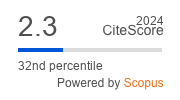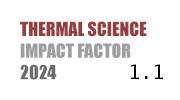THERMAL SCIENCE
International Scientific Journal
ROBOT PARAMETER IDENTIFICATION AND REDUNDANCY ANALYSIS BASED ON ADAPTIVE RIDGE REGRESSION
ABSTRACT
This paper proposes an iterative parameter identification algorithm based on adaptive ridge regression to establish a geometric error model for improving the absolute positioning accuracy of the end-effector of collaborative robots. The perturbation method is employed to establish the aforementioned model. This algorithm addresses the overfitting and lack of regularization issues associated with the least squares method under multicollinearity and high-dimensional data, thereby enhancing the model generalization capability. A parameter redundancy analysis was conducted on the positional error model for multi-degree-of-freedom collaborative robots. The experimental results demonstrate that the elimination of redundant parameters through analytical methods improves the reliability and accuracy of parameter identification and enhances the model robustness. In comparison to the least squares method, the proposed algorithm demonstrates superior identification accuracy and generalization capability, resulting in a notable enhancement in the absolute positioning accuracy of collaborative robots through calibration.
KEYWORDS
PAPER SUBMITTED: 2023-12-01
PAPER REVISED: 2024-06-20
PAPER ACCEPTED: 2024-06-20
PUBLISHED ONLINE: 2025-07-06
THERMAL SCIENCE YEAR
2025, VOLUME
29, ISSUE
Issue 3, PAGES [2095 - 2104]
- Wang, X. V., et al., Human-Robot Collaborative Assembly in Cyber-Physical Production: Classification Framework and Implementation, CIRP annals, 66 (2017), 1, pp. 5-8
- Villani, V., et al., Survey on Human-Robot Collaboration in Industrial Settings: Safety, Intuitive Interfaces and Applications, Mechatronics, 55 (2018), Nov., pp. 248-266
- Xuan, J., Sun, H. X., Review on Kinematics Calibration Technology of Serial Robots, International Journal of Precision Engineering and Manufacturing, 15 (2014), Aug., pp. 1759-1774
- Zhang, T., et al., An Online Prediction and Compensation Method for Robot Position Errors Embedded with Error-Motion Correlation, Measurement, 234 (2024), 114866
- Kang, M., et al., A Robot Positional Error Compensation Method Based on Improved Kriging Interpolation and Kronecker Products, IEEE Transactions on Industrial Electronics, 71 (2023), 4, pp. 3884-3893
- Li, Z., et al., An Overview of Calibration Technology of Industrial Robots, IEEE/CAA Journal of Automatica Sinica, 8 (2021), 1, pp. 23-36
- Denavit, J., Hartenberg, R. S., A Kinematic Notation for Lower-Pair Mechanisms Based on Matrices, ASME Journal of Applied Mechanics, 22 (1955), 2, pp. 215-221
- Xiang, T., et al., Kinematics Parameter Calibration of Serial Industrial Robots Based on Partial Pose Measurement, Mathematics, 11 (2023), 23, 4802
- Hayati, S. A., Robot Arm Geometric Link Parameter Estimation, Proceedings, 22nd IEEE Conference on Decision and Control, San Antonio, Tex., USA, 1983, pp. 1477-1483
- Zhuang, H., et al., A Complete and Parametrically Continuous Kinematic Model for Robot Manipulators, IEEE Transactions on Robotics and Automation, 8 (2002), 4, pp. 451-463
- He, J.-H., et al., A Local POE-Based Self-Calibration Method Using Position and Distance Constraints for Collaborative Robots, Robotics and Computer-Integrated Manufacturing, 86 (2024), 102685
- Selingue, M., et al., Hybrid Calibration of Industrial Robot Considering Payload Variation, Journal of Intelligent & Robotic Systems, 109 (2023), 3, 58
- Cheng, Y. B., et al., Small Sample Uncertainty Evaluation of Industrial Robot Position Accuracy Measurement Based on Grey Model, Measurement Science and Technology, 35 (2024), 8, 086006
- Gao, G. B., et al., Modeling and Parameter Identification of a 3D Measurement System Based on Redundant Laser Range Sensors for Industrial Robots, Sensors, 23 (2023), 4, 1913
- Khayat, F., Identification of Piecewise Constant Robin Coefficient for the Stokes Problem Using the Levenberg-Marquardt Method, Computational and Applied Mathematics, 39 (2020), June, pp. 1-23
- Xu, X. K., et al., A Modeling and Calibration Method of Heavy-Duty Automated Fiber Placement Robot Considering Compliance and Joint-Dependent Errors, Journal of Mechanisms and Robotics, 15 (2023), 6, 061011
- Toquica, J. S., Motta, J. M., A Novel Approach for Robot Calibration Based on Measurement Sub-Regions with Comparative Validation, The International Journal of Advanced Manufacturing Technology, 131 (2024), Aug., pp. 3995-4008
- Deng, Y. H., et al., A Highly Powerful Calibration Method for Robotic Smoothing System Calibration via Using Adaptive Residual Extended Kalman Filter, Robotics and Computer-Integrated Manufacturing, 86 (2024), 102660
- Lim, H. K., et al., A Practical Approach to Enhance Positioning Accuracy for Industrial Robots, Proceedings, 2009 ICCAS-SICE, Fukuoka, Japan, 2009, pp. 2268-2273
- Li, R., et al., Real-Time Trajectory Position Error Compensation Technology of Industrial Robot, Measurement, 208 (2023), 112418
- Hatami, M., et al., Differential Transformation Method for Mechanical Engineering Problems, Academic Press, New York, USA, 2017
- Yun, H., et al., Calibration of Industrial Robots with Spherical Joint Using Single Wire Encoder, Manuf Lett, 33 (2022), Aug., pp. 46-50
- Zhu, Q., et al., Kinematic Self-Calibration Method for Dual-Manipulators Based on Optical Axis Constraint, IEEE Access, 7 (2018), Dec., pp. 7768-7782

